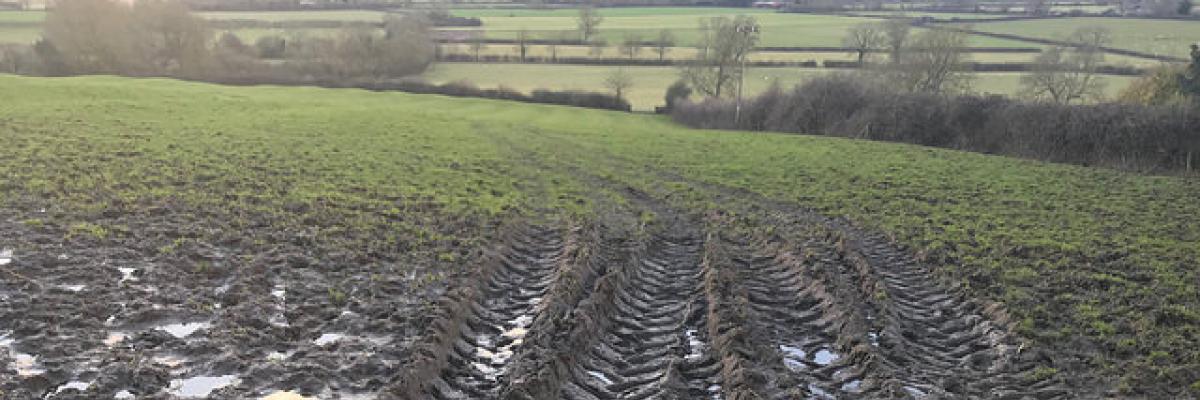
Investing in soil for a resilient future
20 December 2018
When I talk to farmers often it is a case of too much rain, or not enough. Recent experience suggests they might be right - as weather extremes begin to bite it is likely that farmers will be amongst the first to notice. So it is no surprise that there is an increased interest in soils, how they are managed and what farmers, advisers and researchers can do to improve the health, functionality and fertility of the soils in which farmers grow crops.
At the same time we are also recognising that flooding is an increasing threat and a very unpleasant reality for many. Whilst flood defences are critical to protecting communities, the walls can only be so high so there has been a similar growth in interest around natural flood management (NFM); using the natural environment to a greater extent to manage the flow of rainfall before it reaches towns and cities.
I am very fortunate to be part of a NERC funded project led by Dr Joanna Clark (also a farmer’s daughter) at the University of Reading (@NERC_NFM). The aim of LANDWISE is to assess the effectiveness of realistic and scalable land-based NFM measures to reduce the risk from flooding from surface runoff, rivers and groundwater in groundwater-fed lowland catchments. In practice what we are doing is studying how crop choice, tillage practices and soil management activities influence the movement of water and the capacity of soil to hold water. This will help researchers and policy makers to undestand which activities have the greatest potential to assist in the reduction of flood risk. We know that soil has the ability to increase infiltration, evaporative losses and/or below-ground water storage, thereby helping to store precipitation to reduce surface runoff and slow down the movement of water to reduce peak levels in groundwater and rivers.
However, we need to carefully examine the balance between increased infiltration, soil water storage and evaporative losses under different types of NFM measures, because long-term increases in infiltration could actually increase groundwater and river flood risk if there is less capacity within the ground and in rivers to store excess precipitation from storm events.
Currently the NFM models suggest that land-based NFM measures would only provide effective protection against small flood events in small catchments. Indeed they go on to predict that as the catchment size and flood events increase, the effectiveness of land-based NFM measures in reducing flood risk would decrease significantly. What LANDWISE is doing is gathering the evidence to see if the models are accurate by attempting to answer the gaps in knowledge that make it hard to include land-based NFM measures in flood risk mitigation schemes.
The potential of land-based NFM measures relates to more than just reduce flood risk, as it covers issues such as improving water quality, biodiversity and sustainable agriculture. Given the current discussions around public money for public goods, this would seem to be crucial.
So how can you help? LANDWISE needs to understand how farmers currently use different types of soils and crops so that we can create sensible and realistic scenarios and to identify which areas to investigate further within our research. To help with this we have devised a short survey - experience has shown farmers/landowners have completed it in under 10 minutes. If you are a farmer, please take a few minutes to answer the questions:
https://glos.onlinesurveys.ac.uk/landwise
The findings will be really helpful in understanding the challenges that all farmers face when managing their land and the changes that they may have, and may wish to make in the future. Such information is really important for shaping future policy and decision-making regarding both national and local schemes and programmes. The survey may enable us to identify practices which are also beneficial agronomically.
Thank you, and I promise another blog sharing the early results in 2019!
Chris Short writes of himself:
"I have been in academia for over 25 years now but my roots are in farming - my father was a corn merchant and my mother a farmer’s daughter. I also manage a small piece of species rich limestone grassland currently under HLS. So it was not the plan to climb to be Reader in Environmental Governance at the University of Gloucestershire but it is a job I enjoy for the breadth of the research opportunities and the chance to facilitate the learning of the students I meet. My long-term aspiration has been to challenge the notion that agricultural and the environment are separate ends of a spectrum. Sometimes the simplest most ‘natural’ solutions are also the best for the long-term health of both agriculture and the environment. Now the term is nature-based solutions, an example of which is natural flood management that seeks to use the local environment to help reduce the risk of flooding. I have lived in Gloucestershire for most of my life and I love walking through the valleys and hills with my dog in all seasons and weather. I am also Chair of the Upper Thames Catchment Partnership and a member of the Board of the Gloucestershire Local Nature Partnership. Here I try to live out in practice the partnership ideals that I both teach and research. For the environment, agriculture and society I believe we are better off together."
Chris is based at the Countryside and Community Research Institute (CCRI) at the University of Gloucester. You can follow their activities at @CCRI_UK or keep in touch with Chris @chrisshortccri


